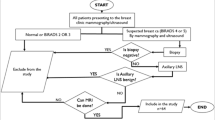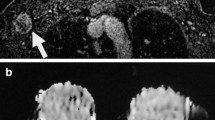Abstract
Background
The purpose of this study was to examine the utility of high-resolution magnetic resonance (MR) lymphography using ultrasmall superparamagnetic iron oxide (USPIO) in the evaluation of axillary lymph nodes in patients with early stage breast cancer.
Methods
Ten women with breast cancer without swollen axillary lymph nodes were enrolled in this study. High-resolution MR lymphography was performed 24 h after administration of USPIO. On the MR examination, a 3-inch surface coil was placed on the sentinel lymph node (SLN) parts as defined by a radioisotope (RI) scintigraphy method, and T2*-weighted (T2*W) and T1-weighted (T1W) images were obtained. Detected nodes were differentiated as normal or diseased nodes by the enhancement patterns. The day after MR examination, SLN biopsy (SNB) was performed. The imaging results were compared to the histopathologic findings.
Results
On MR images, the mean number of detectable nodes was 7.9 per patient. Eight patients who histopathologically had no metastatic lymph nodes were diagnosed as nonmetastatic and two patients who had 3- and 6-mm metastatic areas in the node, respectively, were diagnosed as metastatic preoperatively. No side effects were noted.
Conclusions
High-resolution MR lymphography using USPIO enabled us to obtain good axillary lymph node evaluation results. These results suggest that this method of imaging may contribute to better preoperative lymph node staging.




Similar content being viewed by others
References
Morrow M. Role of axillary dissection in breast cancer management. Ann Surg Oncol. 1996;3:233–4.
Michel SC, Keller TM, Frohlich JM, Fink D, Caduff R, Seifert B, et al. Preoperative breast cancer staging: MR imaging of the axilla with ultrasmall superparamagnetic iron oxide enhancement. Radiology. 2002;225:527–36.
Pressman PI. Surgical treatment and lymphedema. Cancer. 1998;83:2782–7.
Yeoh EK, Denham JW, Davies SA, Spittle MF. Primary breast cancer. Complications of axillary management. Acta Radiol Oncol. 1986;25:105–8.
Silverstein MJ, Skinner KA, Lomis TJ. Predicting axillary nodal positivity in 2282 patients with breast carcinoma. World J Surg. 2001;25:767–72.
Veronesi U, Paganelli G, Viale G, Luini A, Zurrida S, Galimberti V, et al. A randomized comparison of sentinel-node biopsy with routine axillary dissection in breast cancer. N Engl J Med. 2003;349:546–53.
Sachelarie I, Grossbard ML, Chadha M, Feldman S, Ghesani M, Blum RH. Primary systemic therapy of breast cancer. Oncologist. 2006;11:574–89.
Yoshimura G, Sakurai T, Oura S, Suzuma T, Tamaki T, Umemura T, et al. Evaluation of axillary lymph node status in breast cancer with MRI. Breast Cancer. 1999;6:249–58.
Mumtaz H, Hall-Craggs MA, Davidson T, Walmsley K, Thurell W, Kissin MW, et al. Staging of symptomatic primary breast cancer with MR imaging. Am J Roentgenol. 1997;169:417–24.
Bruneton JN, Caramella E, Hery M, Aubanel D, Manzino JJ, Picard JL. Axillary lymph node metastases in breast cancer: preoperative detection with US. Radiology. 1986;158:325–6.
Harada T, Tanigawa N, Matsuki M, Nohara T, Narabayashi I. Evaluation of lymph node metastases of breast cancer using ultrasmall superparamagnetic iron oxide-enhanced magnetic resonance imaging. Eur J Radiol. 2007;63:401–7.
Anzai Y, Blackwell KE, Hirschowitz SL, Rogers JW, Sato Y, Yuh WT, et al. Initial clinical experience with dextran-coated superparamagnetic iron oxide for detection of lymph node metastases in patients with head and neck cancer. Radiology. 1994;192:709–15.
Bellin MF, Roy C, Kinkel K, Thoumas D, Zaim S, Vanel D, et al. Lymph node metastases: safety and effectiveness of MR imaging with ultrasmall superparamagnetic iron oxide particles––initial clinical experience. Radiology. 1998;207:799–808.
Anzai Y, Prince MR. Iron oxide-enhanced MR lymphography: the evaluation of cervical lymph node metastases in head and neck cancer. J Magn Reson Imaging. 1997;7:75–81.
Harisinghani MG, Saini S, Slater GJ, Schnall MD, Rifkin MD. MR imaging of pelvic lymph nodes in primary pelvic carcinoma with ultrasmall superparamagnetic iron oxide (Combidex): preliminary observations. J Magn Reson Imaging. 1997;7:161–3.
Tatsumi Y, Tanigawa N, Nishimura H, Nomura E, Mabuchi H, Matsuki M, et al. Preoperative diagnosis of lymph node metastases in gastric cancer by magnetic resonance imaging with ferumoxtran-10. Gastric Cancer. 2006;9:120–8.
Nishimura H, Tanigawa N, Hiramatsu M, Tatsumi Y, Matsuki M, Narabayashi I. Preoperative esophageal cancer staging: magnetic resonance imaging of lymph node with ferumoxtran-10, an ultrasmall superparamagnetic iron oxide. J Am Coll Surg. 2006;202:604–11.
Saksena MA, Saokar A, Harisinghani MG. Lymphotropic nanoparticle enhanced MR imaging (LNMRI) technique for lymph node imaging. Eur J Radiol. 2006;58:367–74.
Kanemaki Y, Kurihara Y, Itoh D, Kamijo K, Nakajima Y, Fukuda M, et al. MR mammary ductography using a microscopy coil for assessment of intraductal lesions. Am J Roentgenol. 2004;182:1340–2.
Stets C, Brandt S, Wallis F, Buchmann J, Gilbert FJ, Heywang-Kobrunner SH. Axillary lymph node metastases: a statistical analysis of various parameters in MRI with USPIO. J Magn Reson Imaging. 2002;16:60–8.
Stadnik TW, Everaert H, Makkat S, Sacre R, Lamote J, Bourgain C. Breast imaging. Preoperative breast cancer staging: comparison of USPIO-enhanced MR imaging and 18F-fluorodeoxyglucose (FDC) positron emission tomography (PET) imaging for axillary lymph node staging––initial findings. Eur Radiol. 2006;16:2153–60.
Memarsadeghi M, Riedl CC, Kaneider A, Galid A, Rudas M, Matzek W, et al. Axillary lymph node metastases in patients with breast carcinomas: assessment with nonenhanced versus uspio-enhanced MR imaging. Radiology. 2006;241:367–77.
Tokuhara T, Tanigawa N, Matsuki M, Nomura E, Mabuchi H, Lee SW, et al. Evaluation of lymph node metastases in gastric cancer using magnetic resonance imaging with ultrasmall superparamagnetic iron oxide (USPIO): diagnostic performance in post-contrast images using new diagnostic criteria. Gastric Cancer. 2008;11:194–200.
Harisinghani MG, Barentsz J, Hahn PF, Deserno WM, Tabatabaei S, van de Kaa CH, et al. Noninvasive detection of clinically occult lymph-node metastases in prostate cancer. N Engl J Med. 2003;348:2491–249926.
Schwartz GF, Giuliano AE, Veronesi U. In: Proceedings of the consensus conference on the role of sentinel lymph node biopsy in carcinoma of the breast. 19–22 April 2001, Philadelphia, Pennsylvania. Cancer 2002;94:2542–51.
Author information
Authors and Affiliations
Corresponding author
About this article
Cite this article
Kimura, K., Tanigawa, N., Matsuki, M. et al. High-resolution MR lymphography using ultrasmall superparamagnetic iron oxide (USPIO) in the evaluation of axillary lymph nodes in patients with early stage breast cancer: preliminary results. Breast Cancer 17, 241–246 (2010). https://doi.org/10.1007/s12282-009-0143-7
Received:
Accepted:
Published:
Issue Date:
DOI: https://doi.org/10.1007/s12282-009-0143-7




